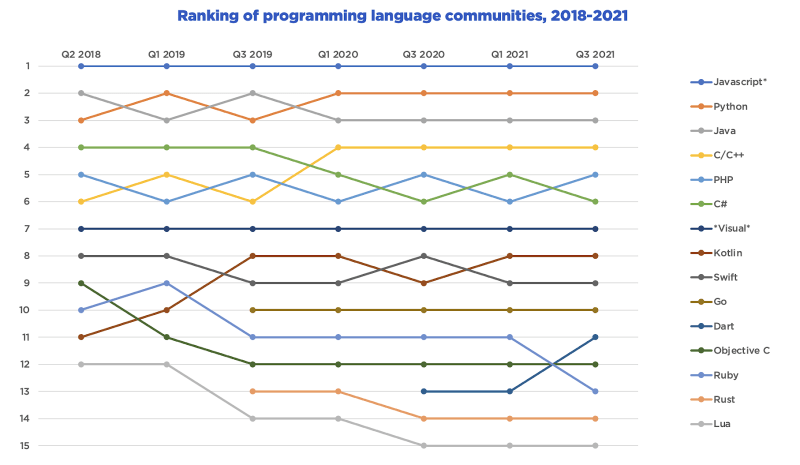Following our last Developer Nation Survey, results are in and our State of the Developer Nation report 21st edition is now available! More than 19,000 developers from around the world participated and shed light on how they learn, the tools they use, how they are involved in emerging technologies, but also what would make them switch employers, among other topics.
As always, programming languages are a beloved subject of debate and one of the first topics we cover. The choice of language matters deeply to developers because they want to keep their skills up to date and marketable. It matters to toolmakers too, because they want to make sure they provide the most useful SDKs.
It can be hard to assess how widely used a programming language is. The indices available from players like Tiobe, Redmonk, Stack Overflow’s yearly survey, or GitHub’s Octoverse are great, but offer mostly relative comparisons between languages, providing no sense of the absolute size of each community. They may also be biased geographically or skewed towards certain fields of software development or open source developers.
The estimates we present here look at active software developers using each programming language; across the globe and across all kinds of programmers. They are based on two pieces of data:
- First, our independent estimate of the global number of software developers, which we published for the first time in 2017.
We estimate that, as of Q3 2021, there are 26.8 million active software developers in the world
- Second, our large-scale, low-bias surveys which reach tens of thousands of developers every six months. In the surveys, we have consistently asked developers about their use of programming languages across ten areas of development, giving us rich and reliable information about who uses each language and in which context.
JavaScript’s popularity has skyrocketed 🥇
JavaScript is the most popular programming language community by a wide margin. Nearly 16.5M developers are using it globally. Notably, the JavaScript community has been growing in size consistently for the past several years. 4M developers joined the community in the last year – by far the highest growth in absolute terms across all languages – and upwards of 2.5M developers joined in the past six months alone. Even in software sectors where JavaScript is not among developers’ top choices, like data science or embedded development, about a fourth of developers use it in their projects.
Back in 2020 we suggested that learning Python would probably be a good idea. It still is. Since it surpassed Java in popularity at the beginning of 2020, Python has remained the second most widely adopted language behind JavaScript. Python now counts 11.3M users after adding 2.3M net new developers in the past 12 months. *The rise of data science and machine learning (ML) is a clear factor in Python’s popularity. *
More than 70% of ML developers and data scientists report using Python
Java is the cornerstone of the Android app ecosystem as well as one of the most important general-purpose languages. Although it has been around for more than two decades now, its traction among developers keeps steadily growing. Since mid-2018, nearly 2.5M developers have joined the Java community, which now counts 9.6M developers.
Rust is rising fast 🚀
The group of major, well-established languages is completed with C/C++ (7.5M), PHP (7.3M), and C# (7.1M). Of these, PHP has grown the fastest in the past six months, with an influx of 1M net new developers between Q1 and Q3 2021. C and C++ are core languages in embedded and IoT projects for both on-device and application-level coding, whereas PHP is still the second most commonly used language in web applications after JavaScript. On the other hand, C# is traditionally popular within the desktop developer community, but it’s also the most broadly used language among AR/VR and game developers, largely due to the widespread adoption of the Unity game engine in these areas.
Rust has formed a very strong community of developers who care about performance, memory safety, and security. As a result, it grew faster than any other language in the last 24 months. Rust has nearly tripled in size from just 0.4M developers in Q3 2019 to 1.1M in Q3 2021.
Rust is mostly used in embedded software projects but also in AR/VR development, most commonly for implementing the low-level core logic of AR/VR applications.
In previous editions of the State of the Developer Nation report, Kotlin has consistently been identified as a rising star among programming languages. Kotlin’s audience has doubled in size over the last three years – from 1.5M developers in Q2 2018 to nearly 3M in Q3 2021. This trend is largely attributed to Google’s decision to make Kotlin its preferred language for Android development. Kotlin is currently the third most popular language in mobile development, behind JavaScript and Java.
The more niche languages – Go, Ruby, Dart, and Lua – are still much smaller, with up to 2M active software developers each. Go and Ruby are important languages in backend development, but Go has grown slightly faster in the past year, both in absolute and percentage terms. Dart has also seen a significant uptick in its adoption in the last year. This has been fuelled predominantly by the increasing adoption of the Flutter framework in mobile development. Finally, Lua was the second fastest growing language community in the past two years, behind Rust, mainly attracting AR/VR and IoT developers looking for a scripting alternative to low-level languages such as C and C++.
What's your favourite programming language? Take our latest survey to support your choice!








Top comments (0)